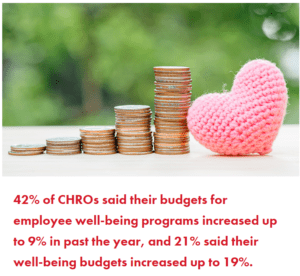Employee stress is at a tipping point; here’s what HR can do.
By Jeanne Meister
HR leaders are facing significant disruption and major challenges, from attracting and retaining talent to addressing increased employee stress and burnout. Executive Network’s The Global CHRO of the Future report identified retention as the biggest challenge CHROs are facing today, with an overwhelming 83% reporting this issue as significant. A record number of workers in the United States have voluntarily resigned from their jobs: Nearly 4.2 million workers quit their jobs in August 2022, according to the Job Openings and Labor Turnover Survey (JOLTS). On top of the high quit numbers, the U.S. economy added 263,000 jobs in September 2022, according to the Bureau of Labor Statistics (BLS).
The real issue is not the rising quit rates but the reason for them. CHROs need to consider what organizations can do to prevent further attrition. One of the factors behind turnover is employees are re-thinking what they want both personally and professionally. The biggest contributing factors to voluntary turnover include:
- employee stress;
- burnout;
- a lack of transparency in career growth; and
- work-life balance issues.
Only 18% of CHROs believed employees were leaving because they want more compensation.
One of the keys to employee retention is redefining employee well-being and mental health strategies. These initiatives should be elevated from merely a perk to a mission-critical business strategy. Four in 10 CHROs (42%) said their budgets for employee well-being programs increased up to 9% in past the year, and 21% said their well-being budgets increased up to 19%.
But increasing the budget may not be enough to decrease employee stress and burnout. CHROs must view well-being holistically by encompassing physical, emotional, financial, career, and social well-being. Employee well-being needs to become a critical business strategy to nurture all aspects of a company’s workforce.
Build a Culture of Well-being
Three out of four adults feel stressed on a regular basis, according to the American Psychological Association’s Stress in America survey. So how can CHROs build a culture of well-being at a time of overwhelming stress? Many factors are causing workers to feel burned out, including the pandemic, inflation, the Russia-Ukraine crisis, the lack of separation between work and home, worries over job security, money, and the economy.
As these disruptions continue, more and more workers will report symptoms of stress and become burned out—and employers will pay a hefty price. According to the American Institute of Stress, job stress and its negative impact on mental health costs U.S. employers nearly $300 billion annually. And it’s not only the general population feeling the heat — HR pros are feeling the same way.
During the past two years, HR’s role has expanded well beyond people management to coping with the challenges brought on by the global pandemic, the shift to remote work, dealing with business continuity plans, mental health, and return-to-office plans. It’s no wonder that HR had the highest turnover rate in the past 12 months, according to LinkedIn data.
The pandemic changed the way people work and caused many to re-evaluate their careers. The last two years have been difficult for everyone, both employees and employers alike. Today’s talent is looking for more than just a paycheck. They are seeking a work culture that supports their well-being and one where they can find purpose and meaning.
Employees need a supportive culture in order to be productive and successful. CHROs who double down on their well-being efforts, offer additional support to address the burnout and stress employees are experiencing, and re-imagine the new role of the office, can help to alleviate today’s retention and recruitment challenges.
Moving forward, organizations must remain focused on the fact that employees are questioning all aspects of their work lives and looking for assistance in their overall well-being. Flexible working arrangements, improved work-life balance, and taking care of the overall wellness of employees are among the keys to keeping employees happy and reducing turnover.
Jeanne Meister is executive vice president at Executive Networks.














